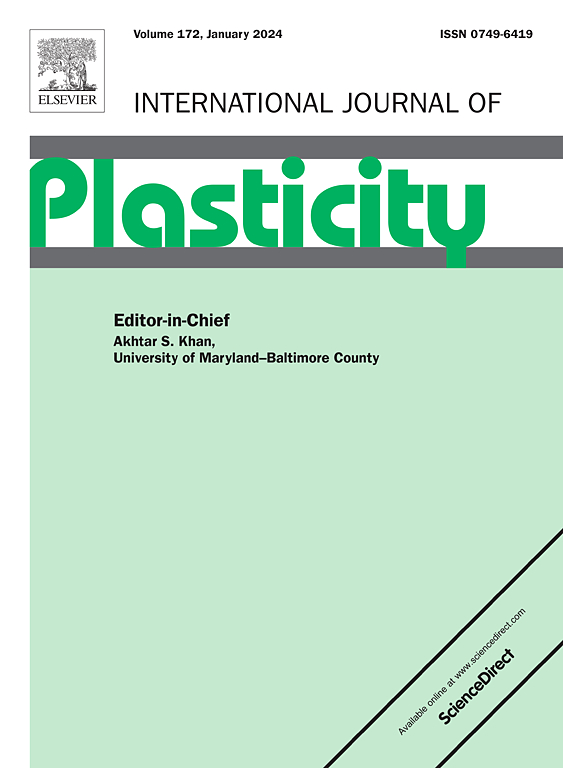通过统计滑移活度分析揭示无织构Mg-10Gd-3Y-0.5Zr合金在拉伸和压缩过程中的不对称析出强化
IF 9.4
1区 材料科学
Q1 ENGINEERING, MECHANICAL
引用次数: 0
摘要
通常,在评价沉淀强化行为时不考虑加载方向。然而,镁合金在拉伸和压缩条件下存在不同的析出强化响应(称为T-C不对称析出强化)。在无织构、无双晶的Mg-10Gd-3Y-0.5Zr合金中,峰时效(T6)处理与固溶(T4)处理相比,拉伸和压缩屈服强度分别提高了103 MPa(+73%)和25 MPa(+11%)。为了理解这一现象,采用基于500多个滑动轨迹观测的滑动轨迹分析,统计分析了各个滑动模式的分布和临界分解剪应力(CRSS)比。衰老诱导的CRSSPyrICRSSPyrI/CRSSPriCRSSPri和CRSSPyrIICRSSPyrII/CRSSPriCRSSPri在拉伸状态下的升高明显大于压缩状态。透射电镜(TEM)分析表明,拉伸时Orowan弯曲是位错-析出相互作用的主要机制,而压缩时则以剪切为主。计算并比较了Orowan弯剪两种滑移模式下的CRSS增量。在所有滑移模式下,Orowan强化始终高于剪切强化。这就合理地解释了与压缩相比,由老化引起的拉伸中YS的增加。此外,降水对拉压复合滑移、交叉滑移和滑移传递频率的影响不同。总的来说,这项工作首次强调了在研究镁合金析出强化时考虑加载方向的重要性。本文章由计算机程序翻译,如有差异,请以英文原文为准。


Unveiling asymmetric precipitation strengthening during tension and compression via statistical slip activity analysis for an untextured Mg-10Gd-3Y-0.5Zr alloy
Loading direction is not usually considered when evaluating precipitation-strengthening behavior. However, different precipitation-strengthening responses under tension and compression (termed T-C asymmetric precipitation strengthening) do exist in Mg alloys. In an untextured and twin-free Mg-10Gd-3Y-0.5Zr alloy, peak-aging (T6) treatment increased the yield strength (YS) by 103 MPa (+73%) under tension and 25 MPa (+11%) under compression, compared with the solid solution (T4) condition. To understand this phenomenon, both the distributions and critical resolved shear stress (CRSS) ratios of individual slip modes were statistically analyzed using slip trace analysis based on over 500 slip trace observations. The aging-induced increases in / and / were significantly greater in tension compared with compression. Transmission electron microscopy (TEM) analysis revealed that Orowan bowing was the dominant dislocation-precipitate interaction mechanism in tension, while shearing was prevalent in compression. The CRSS increments for the individual slip modes were calculated and compared for Orowan bowing and shearing. Orowan strengthening was consistently higher than shearing strengthening for all slip modes. These rationalized the higher aging-induced increase of YS in tension compared with compression. In addition, the precipitation effects on the frequency of multiple slip, cross slip and slip transfer were different in tension and compression. Overall, this work highlights the importance of considering the loading direction when studying precipitation strengthening for Mg alloys for the first time.
求助全文
通过发布文献求助,成功后即可免费获取论文全文。
去求助
来源期刊

International Journal of Plasticity
工程技术-材料科学:综合
CiteScore
15.30
自引率
26.50%
发文量
256
审稿时长
46 days
期刊介绍:
International Journal of Plasticity aims to present original research encompassing all facets of plastic deformation, damage, and fracture behavior in both isotropic and anisotropic solids. This includes exploring the thermodynamics of plasticity and fracture, continuum theory, and macroscopic as well as microscopic phenomena.
Topics of interest span the plastic behavior of single crystals and polycrystalline metals, ceramics, rocks, soils, composites, nanocrystalline and microelectronics materials, shape memory alloys, ferroelectric ceramics, thin films, and polymers. Additionally, the journal covers plasticity aspects of failure and fracture mechanics. Contributions involving significant experimental, numerical, or theoretical advancements that enhance the understanding of the plastic behavior of solids are particularly valued. Papers addressing the modeling of finite nonlinear elastic deformation, bearing similarities to the modeling of plastic deformation, are also welcomed.
 求助内容:
求助内容: 应助结果提醒方式:
应助结果提醒方式:


